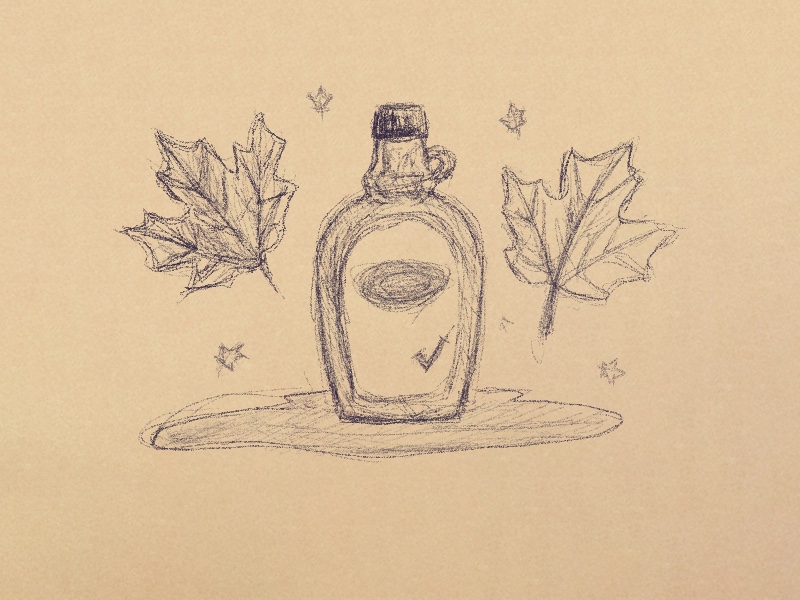By: Arlette Martinez
Canada is known internationally for its maple syrup. Many of us bring maple syrup as a souvenir when visiting friends abroad. Canada is the world’s leading producer and exporter of maple products, exporting over 61 million kg of maple products to over 68 countries in 2020 alone.1

Credits: Illustration by Kit Chokly.
Brigit Ramsingh is an Ottawa-based independent researcher, food writer, and former Senior Lecturer in Food Safety Management at the University of Central Lancashire (2013-2020). Her presentation at the Food and Materialities Conference, “From the Tapped Tree to Your Table’: Marketing Maple Syrup in Early 20th Century Canada,” examined maple syrup advertising from a century ago and how it’s woven into the daily diets and social lives of Canadians.
Ramsingh’s research takes a critical and historical approach to studying how maple syrup became an integral part of the Canadian identity and how advertising promoted maple syrup’s nutritional value as “healthy.”
Maple sugar production began among settlers in the late 1700s and early 1800s. French settlers learned from the Indigenous peoples how to tap trees to obtain sap and boil it to reduce it to syrup or sugar slabs to store for later use.1,2 According to Ramsingh, it was the first kind of sugar produced in eastern North America and remained the standard sweetener until 1875, when cane sugar became more available and affordable.
Ramsingh explained that the US was the largest maple syrup producer at the time, particularly in the New England region. She looked at how Canadian producers coordinated efforts to establish a domestic market through advertising campaigns and recipe creation. According to her findings, the marketing of maple syrup (sold initially as sugar bricks) began in the early twentieth century, led by cooperatives such as the Québec Maple Sugar Producers’ Society. “One aspect is this particular federal advertising campaign I looked at, which tried to sell it and get the message out across Canada that this is something because markets were drying up south of the border due to tariffs and a bit of a trade war brewing. And so, there’s a real push to sell Canadian maple syrup to Canadians.”
According to Ramsingh, women’s institutes3 were crucial in convincing Canadian mothers to embrace maple products as nutritious and safe for their children: “These institutes created recipes like maple blanc-mange, maple candied rice, and maple peanut brittle”. Ramsingh found that the messaging featured along with these products was a romanticized version of the production process and flowing sap. Despite rampant problems with adulteration, maple products were promoted as ‘pure’ sugar (distinct from cheaper cane sugar) and presented as a better source of iron.
In the early 20th century, health was used as an angle to market maple syrup, emphasizing its ‘purity.’ Ramsingh explained that iron and micronutrient deficiency was a concern; she found early pamphlets from the Quebec government that suggested maple syrup was a good source of iron for anemic people.
“By the 1930s, adverts in magazines, displays at railway stations, and educational events in schools advertised maple syrup as the ‘safe sweet for children’ – safeguarded all the way ‘from the tapped tree to your table.”
Ramsingh argues that maple syrup and sugar have a reputation for healthy food, partly because cane sugar was vilified as a dangerous product historically. Nowadays, honey, agave, maple syrup, and maple sugar are considered more nutritious alternatives than other overprocessed sweeteners. Maple sap does have more trace nutrients and minerals in it, and sometimes the nutritional value is overemphasized in marketing efforts worldwide. While living in Britain, Ramsingh noticed a marketing firm was sponsoring a women’s football team and promoting maple syrup as a sporty, healthy, ‘sugar for athletes’ at the same time. Maple syrups’ nutritional advantages are more minerals and producing a lower glycemic index, meaning it would not cause a blood sugar spike as other sugars do. “It still doesn’t give you a license to drink a gallon of it and assume it’s healthy”, noted Ramsingh.
Ramsingh explains that maple syrup’s swift change from sweet treat to healthy alternative likely happened during the 80s and 90s. However, the emphasis on nutrition increased more recently, especially with the rise of veganism, because maple syrup is more vegan friendly than honey, for example. Ramsingh has found that marketing is a powerful tool to exploit food trends.
“Living abroad, I noticed that people have this view of Canada, and they may not know the specific provinces. Using all of Canada and the maple leaf because it’s on the flag seems like a profitable marketing strategy in that sense. Still, a lot of it is fueled by the Canadian government, although the provinces have increased their marketing efforts”.
Lately, Ramsingh has noticed producers and chefs are pushing the envelope by creating new products and recipes. For example, maple water, yogurt, flavoured spirits, baked goods, and savoury sauces. She is excited to see both people’s innovation and the new research possibilities.
I found this conversation fascinating because when I travel abroad, my friends always ask for a bottle of maple syrup. So I wondered Ramsingh if this happens to her too and if they ask for any other Canadian products. She said, “Maple syrup is kind of the big one. Ice wine is another product that’s been big. Smoked salmon from BC is another one.”
We think of maple syrup as distinctively Canadian. But as I learned talking to Brigit Ramsingh, the government and maple syrup producers purposely created this part of the Canadian ‘identity,’ and its marketing has changed over time. I will make sure to remember this conversation the next time I give someone a can of maple syrup.
Sources:
- Werner, Leo H. (2018). “Maple Syrup Industry.” The Canadian Encyclopedia, https://www.thecanadianencyclopedia.ca/en/article/maple-sugar-industry#
- Agriculture and Agri-Food Canada. (2011). “Maple Products Sector Information.”, http://www5.agr.gc.ca/resources/prod/Internet-Internet/MISB-DGSIM/CB-MC/PDF/4689-eng.pdf
- Women’s institutes were founded in 1897 and were spaces for Canadian women to engage and participate in education, family health, and community service. (https://www.fwic.ca/history)